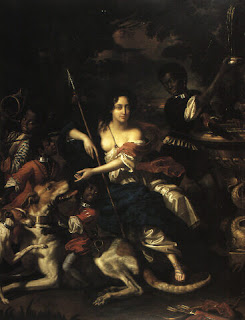Susan reports:
My last visit to Colonial Williamsburg this spring happened to coincide with the American release of Apple's new iPad, the electronic device that has all of publishing holding their collective breaths. Worry not: a lengthy discussion of how exactly the iPad and other e-readers will ultimately change our concept of books has no place here in our small, historically nerdy-girl world. But as I stood in the printer's shop at CW, my head spun with the enormous difference between Now, and Then.
In the 1770s, the printer owned the actual printing press and the business. The printer oversaw the business, taking orders as well as editing the copy, and often even writing it as well. In the case of newspapers, the printer's duties could also include choosing which articles to "borrow" from other papers (for this is well before copyrighting) and selling and writing advertisements and public notices for lost property.
All printed matter began with movable type, one single cast-lead letter at a time. The best type was Dutch or French, and costly enough that an average printer set each page or signature at time, ran off the number of sheets required, and then broke up the type to reuse it. The compositor arranged the type and each page's layout; this required both skill and literacy as well as an "eye," especially since everything was done entirely in reverse. The pressman was hired more for brawn than brains, working the heavy wooden press and making the impression into the paper. Together the pair created the printed page, but even working as a team, it wasn't a speedy process. Setting type for a single newspaper page could take twenty-five hours or more; for the single page of a book, composition could take six hours.
Six hours! And that didn't preparing the paper, inking the type, making the impression, or drying the sheets, and it certainly didn't include the cutting, trimming, stitching, and binding that were part of the bookbinder's trade. (See here for more step-by-step information about 18th c. printing.) As I watched the demonstration, I thought of this blog, and how quickly I can "publish" my writing for readers by way of Blogger. In less than an hour's time, I can write a blog, choose and size my illustrations, "compose" it, and then with a single ink-free finger, distribute it to all of you around the world. What 18th c. printer could even conceive of such a luxury? Or, in turn, how can I imagine reverting to such a laborious and time-consuming process?
But there was one distinct part of the CW printer's shop that felt exactly the same: the owner of the shop in the 1770s was a woman – the wonderfully named Clementina Rind.
Interested in reading an 18th c. newspaper like the one being printed on the press in Colonial Williamsburg, above? Here are all the issues of The Virginia Gazette from 1774, page by page.
Laws Concerning Women in 1th-Century Georgia
1 year ago










































 One of us --
One of us -- 


